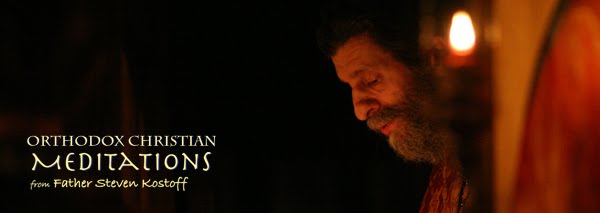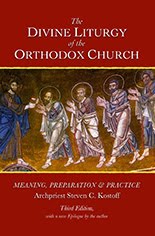
Dear Parish Faithful & Friends in Christ,
CHRIST IS RISEN!
INDEED HE IS RISEN!
INDEED HE IS RISEN!
In the Gospel According to St. Mark, we hear of the discovery of the empty tomb by the myrrhbearing women "very early on the first day of the week." (16:1) This would be the day after the Sabbath, or our Sunday - the "Lord's Day." Since that astonishing morning until this day, Sunday is the most prominent day of worship for Christians, for it was on this day that the resurrection of the Lord was made manifest to the world. And that manifestation was first made to the group of women disciples we know collectively as "the myrrhbearers."
St. Mark specifically mentions "Mary Magdalene, and Mary the mother of James, and Salome" who "bought spices, so that they might go and anoint him." (16:1) These loyal and loving women had come, somewhat counter-intuitively, to anoint the body of the dead Jesus, though they were aware of the large stone that had been rolled "against the door of the tomb." (15:46) Or, perhaps it was a deeper intuition that brought them to the tomb in the hope that they could fulfill their ministry to the Lord. St. Mark narrates: "And very early on the first day of the week they went to the tomb when the sun had risen." (16:2) The "risen sun" is certainly a wonderful anticipation of what the women were soon to discover. Yet, having arrived at the tomb where Jesus had been laid, "looking up, they saw that the stone was rolled back; for it was very large." (16:4)
The myrrhbearing women will now enter an empty tomb. Indeed, why was it empty? The empty tomb needed interpretation, or the women would be lost in distressful and fruitless speculation. The interpretation of the empty tomb will simultaneously be the proclamation of the "Good News." The interpreter and proclaimer will be "a young man sitting on the right side, dressed in a white robe" (16:5), clearly an angel. And that means that was he proclaims will be a divine revelation. In his presence, the women "were amazed." (16:5). The strength of the Gk. word for "amazed" (used only here in the entire NT by St. Mark) has been further translated as "a strong feeling of awe and agitation in the face of the numinous" (D. E. Nineham), or even a "shuddering awe." (A. E. J. Rawlinson) It is at this point in the dramatic narrative that we hear the "Good News" referred to above: "And he said to them 'Do not be amazed; you seek Jesus of Nazareth, who was crucified. He has risen, he is not here; see the place where they laid him'." (16:6) The tomb is empty because Jesus had been raised from the dead! It was the will of God, that the women have the privilege of discovering this. In the words of Peter Chrysologus:
He did not roll back the stone to provide a way of escape for the Lord but to show the world that the Lord had already risen. He rolled back the stone to help his fellow servants believe, not to help the Lord rise from the dead. He rolled the stone for the sake of faith, because it had been rolled over the tomb for the sake of unbelief. He rolled back the stone so that he who took death captive might hold the title of Life. SERMON 75.4
This is a bodily resurrection, and not in some vague spiritual or "metaphorical" sense. Jesus of Nazareth, who had been crucified and buried, had been raised. The "Jesus of history" and the "Christ of faith" are one and the same. The resurrection reveals an awesome transformation, but it is Jesus of Nazareth who is transformed, thus assuring the continuity that is essential to reveal the victory over death that occurs in the resurrection.
The myrrhbearers then hear a further revelation from the angel: "But go, tell his disciples and Peter that he is going before you to Galilee; there you will see him, as he told you." (16:7) This is in fulfillment of Christ's earlier words: "But after I am raised up, I will go before you to Galilee." (14:28) The Gospel According St. Matthew will record such an appearance of the Risen Lord to His disciples in Galilee. (MATT. 28:16-20) Then the women, apparently in that same state of amazement "fled from the tomb; for trembling and astonishment had come upon them; and they said nothing to any one, for they were afraid." (16:8) I hope and pray that at some point in the paschal season; or at any time during the year - or during our lifetime! - we too can "tremble" and be filled with "astonishment" that Jesus has been raised from the dead. Is this an enigmatic ending to the initial discovery of the empty tomb and the proclamation of the resurrection? Did the myrrhbearing women fail in their ministry as "apostles to the apostles" because of their (initial) silence? I believe that St. Mark is leaving us with the overwhelming sense of precisely encountering a divine reality that initially did leave the women speechless. As a scholar of this Gospel has written:
The women's profound emotion is described in order to bring out the overwhelming and sheerly supernatural character of that to which it was the response (see also 4:41, 6:30, 9:15), and perhaps to suggest to the reader that if he has even begun to understand the full significance of what had occurred, he too will be bound to respond with amazement and godly fear." (D. E. Nineham, St. Mark, Pelican New Testament Commentaries, p. 447-448).
It is the Resurrection of Jesus Christ from the dead that the Orthodox Church proclaims to this day with faith, conviction and the certainty that God has acted "in Christ Jesus" within history in a decisive and "eschatological" manner, in order to reclaim, restore and renew His fallen creation. Of course, other Christian churches proclaim the very same victory over death in the Resurrection of Christ. However, the Resurrection understood as the bodily resurrection of Jesus Christ has been challenged, "reinterpreted," or rejected by a fair share of biblical scholars and theologians. We need to be fully aware that the bodily resurrection of Christ does not refer to a resuscitated corpse. There is a tremendous element of transformation in the "spiritual body" of the Lord. The mysterious aspect of this transformation is conveyed in many of the scriptural texts that try and describe - perhaps less than adequately, or at least not exhaustively - the risen life of the Lord. Also, a resuscitated Jesus would have died again, as did Lazarus, the daughter of the elder Jairus, and the son of the widow of Nain. But St. Paul affirms: "For we know that Christ being raised from the dead will never die again; death no longer has dominion over him." (ROM. 6:9) There has "arisen" a sad division amongst Christians over this essential issue. To follow Jesus or to believe in Him apart from His bodily resurrection and all that that implies for Christology, anthropology, and eschatology, etc., is to follow "another Gospel." (GAL. 1:7) Such a Jesus did not "trample down death by death." It is a different Jesus and a different religion.
The further words of Peter Chrysologus captures the choice before us when contemplating the empty tomb:
Pray that the angel would descend now and roll away all the hardness of our hearts and open up our closed senses and declare to our minds that Christ has risen, for just as the heart in which Christ lives and reigns is heaven, so also the heart in which Christ remains dead and buried is a grave. May it be believed that just as he died, so was he transformed. Christ the man suffered, died and was buried; as God he lives, reigns, is and will be forever. SERMONS 75.4
CHRIST IS RISEN! INDEED HE IS RISEN!
Fr. Steven







